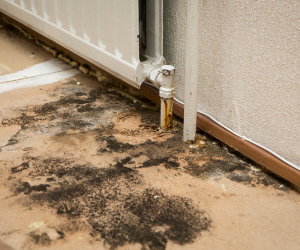Introduction
As heavy rains pour down, our homes provide shelter and protection. However, the aftermath of torrential downpours can leave a hidden legacy of water damage and mold growth.
This blog post will explore the telltale signs of water damage and mold in your home after heavy rains. Understanding these indicators is crucial for timely intervention, necessitating actions such as water damage repair, mold inspection, and enlisting the expertise of reputable mold testing companies.

Musty Odors and Dampness
A distinctive musty odor is often one of the earliest signs of water damage and mold growth in a home. This scent arises from the volatile organic compounds released by mold spores as they increase in damp environments. After heavy rains, detecting a persistent, unpleasant odor could indicate hidden moisture and potential mold growth. It is imperative to address this issue promptly through thorough mold inspection.
Discoloration and Stains
Water damage leaves behind telltale signs on walls, ceilings, and floors. Discoloration and stains are visible indicators of moisture infiltration. Water-saturated materials like drywall and ceiling tiles may exhibit noticeable dark spots or discoloration. Pay close attention to areas near windows, roofs, and basements, as these are common entry points for rainwater. Prompt water damage repair is crucial to prevent further deterioration.
Peeling or Bubbling Paint
Excessive moisture can cause paint to lose its adhesion to surfaces. This often results in peeling or bubbling paint, particularly in areas prone to water exposure. Check walls, ceilings, and wooden surfaces for any signs of paint damage. These areas may require attention for aesthetic reasons and to prevent further water damage.
Warped Or Buckling Flooring
Wooden flooring is particularly vulnerable to water damage. After heavy rains, moisture can seep into the gaps between floorboards, causing them to warp or buckle. If you notice uneven or raised areas in your flooring, it clearly indicates water damage. Prompt water damage repair may include replacing affected sections, which is crucial to prevent further structural issues.
Visible Mold Growth
Mold spores are opportunistic, thriving in environments with excess moisture and organic material. After heavy rains, they can quickly colonize damp surfaces. Keep a vigilant eye out for visible mold growth on walls, ceilings, and hidden corners. Attention to even small patches is essential, as mold can spread rapidly. Engaging professional mold testing companies to conduct comprehensive assessments can provide invaluable insights into the extent of the infestation.
Allergic Reactions and Respiratory Issues
Prolonged mold exposure can lead to various health problems, particularly for individuals with allergies or compromised immune systems. Symptoms may include sneezing, coughing, itchy eyes, and respiratory issues. If you or your family members experience these symptoms, especially after heavy rains, it is imperative to address the potential presence of mold through thorough mold inspection and testing.
Deterioration of Wood and Structural Elements
Waterlogged wood is susceptible to rot and decay. This can weaken the structural integrity of your home. Consider wooden beams, joists, and supports, particularly in basements and crawlspaces. Signs of water damage may include soft, spongy wood, visible mold growth, or areas with a visibly darker hue. Timely water damage repair is crucial to prevent further structural deterioration.
Conclusion
After heavy rains, vigilance is critical to safeguarding your home from the hidden dangers of water damage and mold growth. Recognizing the signs early on empowers homeowners to take proactive steps, including water damage repair, mold inspection, and enlisting the services of reputable mold testing companies. By acting swiftly, you can ensure the health and longevity of your home in the face of nature’s challenges.







